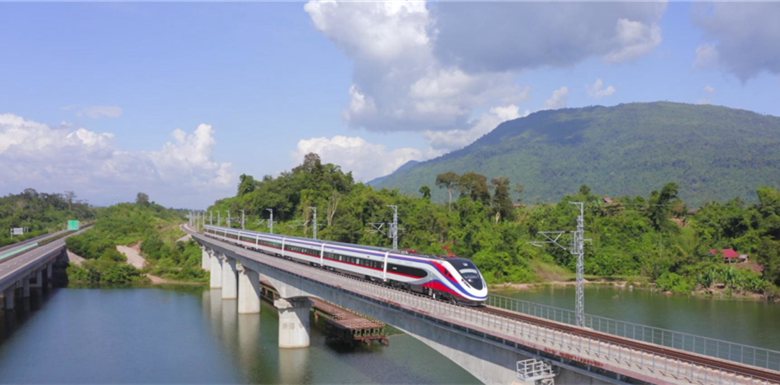
According to CR, the total track length of China-Laos railway is 1,035 km. The section from Kunming to Yuxi, 106 km in length, is an electrified double-track railway with a design speed of 200 km/h, and was completed and open to traffic in December 2016. The new section from Yuxi to Mohan, 507 km in length, is an electrified mixed double- and single-track railway with a design speed of 160 km/h, and was undertaken by China Railway Kunming Group Co., Ltd. The new section from Boten to Vientiane, 422 km in length, is an electrified single-track railway with a design speed of 160 km/h, and was built in BOT mode by CHINA RAILWAY International Corporation Limited together with Laos-China Railway Company Limited, a joint venture between other Chinese shareholders and Laos National Railway Corporation.
China-Laos Railway is an international railway directly connected with China’s railway network. The railway starts from Kunming in southwest China, runs southward to Yuxi, Puer, and Xishuangbanna Dai Autonomous Prefecture, and enters the northern part of Laos via Mohan Railway Port in China and Boten Railway Port in Laos. Then, it continues southward to Louang Namtha, Oudomxay, Luang Prabang, and Vientiane provinces and finally reaches Vientiane, the capital of Laos.
According to CR, the railway crosses many mountains and water systems, and the geological structure along the railway is complex, e.g. high geothermy, high geostress, high seismic intensity, active neotectonic movement, active geothermal water environment, active external dynamic geological conditions, and active shallow bank and slope reconstruction process, making the construction extremely difficult. The construction of the new section from Yuxi to Mohan started in December 2015, and that of the section from Boten to Vientiane started in December 2016. Despite the influence of COVID-19, builders in both China and Laos have overcome numerous difficulties by coordinating resources, strengthening construction organization, and innovating technologies and methods, and ensured orderly, quality and efficient construction of the project. 167 tunnels (e.g. Anding Tunnel, Sen No. 2 Tunnel, and Friendship Tunnel) and 301 bridges (e.g. Mekong River Super Long Bridge in Luang Prabang and Yuanjiang Double-track Super Long Bridge) have been built, totaling 712km and accounting for 76.5% of the total railway length; 38 new stations and 32 traction (distribution) substations have been built, and 1,677 km overhead contact wires have been erected.
The construction of China-Laos Railway adheres to the concept of harmonious human-nature coexistence. Ecological environment protection measures have been taken during the whole process of route planning and selection, construction management, and operation & maintenance. The railway bypasses the environmental sensitive areas such as the core area of Luang Prabang World Heritage Site, Vang Viang Karst Scenic Spot in Laos and Olive Dam Scenic Area in China. Migration channels and protective fences are set up for wild Asian elephants. Optimized earthwork excavation scheme has minimized the impact on the ground vegetation, and nearly 5,000 mu of temporary land have been reclaimed and reused. Soil and water conservation, waste residue utilization, energy-saving and environmental protection materials and other advanced technologies have been adopted. The total greening area along the railway reaches 3.07 million square meters, demonstrating a green and environmental friendly railway project.
Amid the construction of the railway project, the governments of China and Laos have always strengthened risk prevention and control, established the guarantee system for a clean and honest project, and carried out joint supervision of discipline, thus achieving the objectives of building a clean and honest railway of “high engineering quality and excellent talents”. The builders from both sides have worked hand in hand to overcome difficulties and have cultivated profound friendship between the two peoples. They’ve also joined in emergency rescue, medical assistance, education donation as well as other activities for public welfare. As the project generates 110,000 local jobs, it has helped Laos build nearly 2,000 km of road drains, and purchased more than RMB 5.1 billion worth of local materials and equipment.
According to CR, the “Lancang” EMU designated for China-Laos railway was procured by Laos-China Railway Company Limited via bidding and jointly manufactured by the subsidiaries of China Railway Rolling Stock Corporation (CRRC). CR presided over the design and the manufacturing where the mature technologies of China’s “Fuxing” Power Centralized EMUs were taken as reference with adaptive changes being made according to the environment and the routes for cross-border transport. It stands out for its technology, safety, reliability, transport capacity, riding comfort and economic performance. The name “Lancang” - originated from the ancient “Lancang Kingdom” in Laos and the Lancang River flowing through the two countries – is symbolic, meaning that China and Laos are good neighbors, good friends, good comrades and good partners separated only by a strip of water. With a streamlined design, the “Lancang” EMU takes the colors of the Laos national flag – “red, blue, and white” – as the coating showcasing its aesthetics, while the interior takes the themes of the “Bloom of Dok Champa” and the “Grace of Landscape”.
With the highest speed of 160 km/h and a seating capacity of 720 persons, the “Lancang” EMU uses a 9-car formation with one car for power, one for first class, one for dining and six for second class, and it can be coupled for operation when necessary. The EMU has spacious and bright environment, smart air conditioning, ergonomical seating (accessible seats included) with China and Lao standard socket(s) for each set, display of travel information, broadcast and signs in Chinese, Lao and English, dining car and accessibility facilities.
According to CR, before the China-Laos Railway is put into operation, both parties made careful preparations, installed monitoring and warning systems for rainfall, strong wind, and foreign object intrusion in key places of the line to prevent natural disasters, completed the static acceptance, dynamic acceptance, operation test, equipment test and safety assessment of the railway in an orderly manner, performed thorough and accurate adjustments for the equipment and facilities to ensure that the line is fully ready for operation, installed computerized and networked ticketing and passenger service systems and meticulously designed station entrance and exit streamlines at all major passenger stations in the Lao section to offer convenient and thoughtful travel experience for the Lao people, and staffed more than 1,100 operations management and equipment maintenance personnel, including over 500 Chinese employees and over 600 Lao employees. All employees have undergone strict training and examination and are qualified for work.
During the initial operation phase of the China-Laos Railway, China Railway Kunming Group Co., Ltd. has been entrusted by Laos-China Railway Company Limited to operate and maintain the Laos section of the railway. The railway departments of China and Laos have formulated the train operation plan under the conditions of epidemic prevention and control; 2 pairs of cross-border freight trains will be operated daily from Kunming to Vientiane South; point-to-point EMU passenger trains are operated between Vientiane and Boten, and between Kunming and Mohan, including 2 pairs of EMU trains per day between Vientiane and Boten, and 17.5 pairs of EMU trains at the maximum per day between Kunming and Mohan. Both parties will dynamically adjust the operation plan of passenger and freight trains according to the epidemic prevention and control situation and the change in passenger and freight transport demand. After the China-Laos Railway is put into operation, it takes only 5 hours and 20 minutes to travel from Kunming to Mohan, and 3 hours and 20 minutes from Boten to Vientiane on the fastest train. Adding the time for customs clearance at the port, passengers from Kunming can reach Vientiane in about 10 hours.
According to CR, during the initial operation phase of China-Laos Railway, a total of 25 stations, including Kunming, Yuxi, Yuanjiang, Puer, Xishuangbanna, Muang Xai, Luang Prabang, Vang Vieng, Phonhong and Vientiane, are put into operation, with each of them featuring its own special landscape. The station buildings are designed in combination with local culture and equipped with advanced and sufficient facilities, thus offering quality service to passenger and freight transportation. Puer Station, based on the design concept of “a courier station in Yunnan on the Ancient Tea Horse Road”, has 5 platforms and 8 tracks, known as “a station with tea fragrance”. Xishuangbanna Station is equipped with 5 platforms and 7 tracks, and the roof is shaped like a peacock dancing in his pride, revealing the design concept of “peacock dancing against colorful clouds in sublime Xishuangbanna”. Luang Prabang Station, located in this sacred ancient capital city in northern Laos, has 2 platforms and 4 tracks, and it is a station with most exquisite and complex design, with the gabled roof of Wat Xieng Thong in Laos as its inspiration. Vientiane is known as the “city of sandalwood and the capital of forests”. Vientiane Station has 3 platforms and 5 tracks. It is the largest passenger station in Laos, with its building covering an area of 14,500 square meters, which can accommodate up to 2,500 passengers waiting for trains. Vientiane South Station is a hub station on Laos-Thailand Railway with 5 arrival-departure tracks, enabling transshipment of goods between railways with different gauges. Mohan Station and Boten Station adopt integrated design and key technologies of cross-border interconnection. Arrival-departure tracks for domestic and international trains are set, making it a port station that can realize rapid customs clearance.
Passengers can enjoy the feast of unique natural and cultural landscape along the line by taking EMU trains of China-Laos Railway. Passengers can arrive at the scenic spots and historical sites such as Pha That Luang and Patuxay within half an hour by bus from Vientiane Station. You can appreciate the thousand-year-old ancient city of Luang Prabang and visit the well-known Wat Xieng Thong and Royal Palace Museum by taking a bus within half an hour from Luang Prabang Station. If you arrive at Vang Vieng Station, you can enjoy the natural beauty, and go rafting or exploring in Nam Song River. You can experience nature reserves and scenic spots such as Wild Elephant Valley and Ganlanba by taking a bus within one hour from Xishuangbanna Station. You can experience the ancient Tea Horse Road in southern Yunnan and enjoy the original tea garden scenery by taking a bus within half an hour from Puer Station.
According to CR, the opening and operation of China-Laos Railway will initiate a new era of railway transport in Laos, profoundly change the transport pattern in Laos, and transform Laos from a “landlocked country” into a “land-linked country”. It will greatly facilitate people’s travel, promote the progress of tourism, agriculture, water conservancy and other resources, as well as the urbanization along the line, and boost the development of economic parks such as the Vientiane Saysettha Comprehensive Development Zone and the China-Laos Mohan-Boten Economic Cooperation Zone. It is also significant to enhance the economic, social and cultural cooperation and exchange between China and Laos, speed up the construction of China-Laos Economic Corridor and build a China-Laos Community of a Shared Future. As the backbone of the Trans-Asian Railway, China-Laos Railway will also turn into a “golden key” for Laos to connect China to the north and ASEAN countries such as Thailand and Malaysia to the south, exerting a positive impact on the China-ASEAN Free Trade Area and the Greater Mekong Subregion Economic Cooperation.
 附件:
附件:Copyright © 2015-2023 CHINA RAILWAY All Rights Reserved


